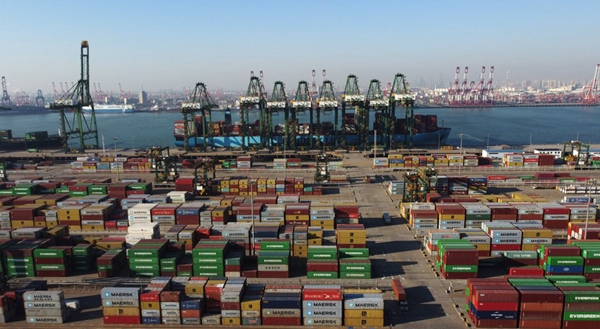China lowers tariffs to boost high-quality growth, high-level opening-up
 0 Comment(s)
0 Comment(s) Print
Print E-mail Xinhua, December 25, 2021
E-mail Xinhua, December 25, 2021

A sweeping number of import items will enjoy lower tariffs next year as China has made new tariff adjustments for trade pacts, soon to take effect, amid efforts to improve the quality of life and boost opening up.
The Customs Tariff Commission of the State Council announced earlier this month to implement provisional tariffs that are lower than the most-favored-nation rates on 954 imported commodities starting Jan. 1, 2022. The figure saw an increase from 883 last year and 859 in 2019.
"Many of the imports on the list are heavily featured in people's daily lives so that foreign firms can benefit from China's development," said Mei Xinyu, a researcher with the Chinese Academy of International Trade and Economic Cooperation under the Ministry of Commerce.
The country will also grant zero-tariff treatment on 98 percent of taxable items originating in the least-developed countries, according to the commission.
Aiming for high quality
According to experts and industry insiders, imports included in the adjustments tell tales of improving livelihood and industrial upgrade aimed at low-carbon outcomes, both traits of high-quality growth.
Tariffs on medical products such as a new cancer drug and artificial joints have been lowered -- a continuation of similar moves in recent years to reduce medical costs and bolster public health.
Since 2018, China has either exempted or lowered tariffs on two batches of cancer drugs, artificial cardiac valves and hearing aids.
Tariffs on some aquatic products, baby clothing, artworks, ski gear are slashed to accommodate consumer demand for quality lifestyles and winter sports, said the commission.
The 954 products also include auto parts that help cut greenhouse gas emissions, as well as high-voltage cables for high-speed trains and fuel-cell components that are expected to bolster high-tech manufacturing.
Meanwhile, the average tariff rate on 62 products of information technology will be slashed from 3.4 percent to 1.7 percent starting July 1, 2022.
These moves will help keep domestic industrial and supply chains stable, spur innovations and industrial upgrade, as well as advance low-carbon development, analysts and industry insiders say.
High-level opening up
The new adjustments follow China's overriding trend of tariff reduction in the past two decades. The country has cut its overall tariff rate from 15.3 percent in 2001 to 9.8 percent in 2010 to fulfill its accession commitment to the World Trade Organization (WTO), before bringing it further down to 7.4 percent currently.
In latest efforts toward high-level opening up, China will impose conventional tariff rates on some products from 29 countries and regions in accordance with relevant trade agreements and preferential arrangements, resulting in lower tariffs on products from countries including New Zealand, Peru, Switzerland, Pakistan, Mauritius, and Costa Rica.
The country also introduced lower or zero tariffs in accordance with trade agreements under the Regional Comprehensive Economic Partnership (RCEP) and the new free trade agreement between China and Cambodia, both to come into effect beginning 2022.
While China had already made tariff cuts with certain members of the RCEP, the 2022 adjustments covered more products, showcasing China's commitment to tariff arrangements under the world's largest free trade agreement, said Cui Fan, a professor at the University of International Business and Economics.
"China's compliance to trade rules under the RCEP will help advance China's high-level opening up, and in turn boost the integration of industrial, supply and value chains between the RCEP members, injecting impetus into world economic recovery," said Cui.
Under the RCEP, China and Japan will see the first bilateral tariff cuts in the form of zero-tariff treatment on 24.9 percent of imported items from Japan and 55.5 percent of imported items from China in 2022. Companies from both sides are expected to benefit from the agreement.
Experts say that China's current overall tariff level, which is nearing that of many developed countries and still decreasing, will help facilitate global trade with lower costs.
In the first three quarters of the year, China's merchandise imports accounted for around 12 percent of the world's total, up from 11.54 percent in 2020, according to WTO data. Its foreign trade value expanded 22 percent year on year to 35.39 trillion yuan (about 5.56 trillion U.S. dollars) in the January-November period.
China has vowed to expand high-quality and institutional opening-up, grant foreign-funded enterprises national treatment, attract more investment from multinational companies, and facilitate the early implementation of major foreign-invested projects in 2022, according to the tone-setting annual Central Economic Work Conference early this month.
To that end, China is working on a slew of measures on top of tariff reductions like shortening the negative list for foreign investment and introducing a negative list for cross-border services trade in the country's free trade zones.






Go to Forum >>0 Comment(s)